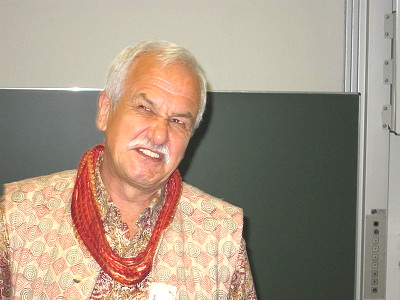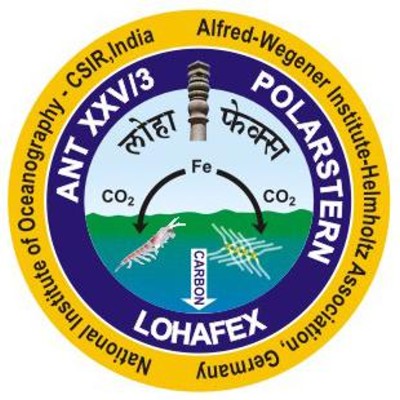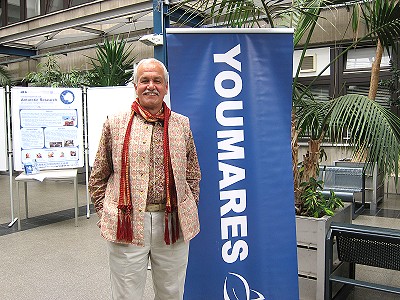 Nos conocimos Prof. Victor Smetacek en el reciente Foro de la Sociedad Alemana para la Investigación Marina (DGM) en Bremen, donde dio una de las charlas de impulso y aprovechiamos la oportunidad para ponerle algunas preguntas sobre dónde ve el futuro de la investigación marina frente al cambio global.
Nos conocimos Prof. Victor Smetacek en el reciente Foro de la Sociedad Alemana para la Investigación Marina (DGM) en Bremen, donde dio una de las charlas de impulso y aprovechiamos la oportunidad para ponerle algunas preguntas sobre dónde ve el futuro de la investigación marina frente al cambio global.
Victor Shahed Smetacek was born in 1946 in India and acquired his B.Sc. in Biology in Nainital, India in 1964. He was awarded a scholarship to study Marine Biology at the University of Kiel, Germany where he received his PhD degree in 1975. His early research focussed on plankton ecology of coastal waters of northern Europe. In 1986 he was appointed Professor of Bio-Oceanography at the University of Bremen and Head of the Pelagic Biology Section of the Alfred Wegener Institute Helmholtz Centre for Polar and Marine Research in Bremerhaven, Germany. His research focus shifted to the biology of sea ice and ice-covered waters, including krill, and the role of Southern Ocean plankton in the global carbon cycle.
He has served as Chief Scientist on 8 interdisciplinary, international cruises on board RV “Polarstern” the last three of which carried out iron fertilisation experiments in the Antarctic Circumpolar Current. Smetacek has supervised numerous PhD students and published a number of papers in leading scientific journals and books on a variety of themes pertaining to the structure and functioning of planktonic ecosystems with emphasis on the links between ecology and biogeochemistry. He has served on the International Scientific Steering Committee of various research programmes, on the Scientific Councils of institutions in Germany and abroad and has received several prestigious awards for excellence in research.
MM: What do you see as the greatest threat to the ocean in the face of global change?
VS: In view of the interconnectedness of the oceans, atmosphere and land masses it is difficult to identify a single greatest threat to the oceans but if I had to make a choice I would say that it is the relentless removal of animals by humans, in particular the large and abundant ones, that troubles me most. It is hard to imagine today how high the density of animal life - not just fish but from molluscs to whales - used to be along the coasts and in parts of the ocean before massive exploitation decimated the stocks. The depredations have been well documented and the papers describing them are often cited, yet I feel that not even the scientific community comprehends what has already been lost and is continuing to be lost to the growing human appetite for sea food.
 The core of the problem is that, in the sea, we are still hunting and gathering natural resources without tending them: this naturally leads to depletion. Since humans are not likely to reduce their demand for sea food in the forseeable future, scientists must develop techniques to practise true, sustainable aquaculture in the open ocean. Today's science fiction dream could become reality tomorrow.
The core of the problem is that, in the sea, we are still hunting and gathering natural resources without tending them: this naturally leads to depletion. Since humans are not likely to reduce their demand for sea food in the forseeable future, scientists must develop techniques to practise true, sustainable aquaculture in the open ocean. Today's science fiction dream could become reality tomorrow.
MM: What do you you see as the most promising questions marine research should ask?
VS: Developing aquaculture techniques in the oceans that, like agricultural fields on land, provide the food humans demand thereby taking the pressure off natural ecosystems. Accepting today's reality as given will not lead to an understanding of how complex systems, such as that of the earth in which we evolved, functions and how it will change in the future. We need to keep the shifting-baseline-syndrome (pointed out by Pauly and Froese) constantly in mind and reconstruct how ecosystems functioned when the stocks of large animals (fish, whales etc.) were still thriving there. The scale of the pillage is convincingly presented by Jeremy Jackson in this TED talk:
My favorite example, because it is well quantified, is the krill/whale relationship in the Southern Ocean: before their decimation (300.000 blue whales were killed in the 1920s and 30s), the whale populations are estimated to have consumed 180 million tons of Antarctic krill annually. This is equivalent to about double the ocean-wide fish catch. See a cartoon version of how the whales nurtured their preferred food here.
While human consumption has led to global decimation of the commercial fish stocks, the whales harvested their food sustainably and in a relatively small corner of the ocean. How this was possible needs to be better researched so that we might be able to emulate it.

The krill fishery is currently growing. Krill stocks have been declining ever since commercial whaling was stopped when whale populations were at their historical low. If we don't provide alternative solutions soon, the sad history of the past will repeat itself, krill populations will plummet further. This could well lead to extinction of the southern race of the blue whale, the largest animal that ever inhabited the planet. They are now believed to number around 2,000, up from 600 or so still surviving when the moratorium was passed in 1964.
MM: Despite much talk about innovation, even social innovation, many people feel more comfortable with the status quo, true to the motto “better the devil you know than the devil you don't know”. How should researchers address the fears of many citizens vis-à-vis change?
VS: We researchers first need to understand how rapidly the world around us is changing. Coping with the various impacts of climate change, in particular sea level rise and the devastation caused by extreme weather events, is going to put severe strain on future generations to maintain the global human civilisation that has been developing over the past decades. So what is called for now is an integration of all the branches of science with the aim of devising and erecting the structures, both abstract and concrete, that can contribute to reducing the rate of ice-cap melt.
By "abstract" I mean the collective mindset of the human population visualised as a mental network acting on the basis of a common logic based on sustainability of the planet as a substrate for human existence. "Human" is not just our genome as a species, but particularly the enlightened mammal that evolved, because it is able to learn from its mistakes.
 I perceive sea level rise as the greatest threat to humanity: just consider the strains climate refugees will cause. It should be pointed out that the sometimes confusing debate on rising sea levels concerns the rate of melting glaciers and not the possibility of melting polar ice caps. Even if emissions are drastically stopped now, the amount of CO2 already in the atmosphere is going to stay there for thousands of years. It will be eventually taken up by the oceans via acidification of the surface layer. Increases in non-fossil fuel sources of greenhouse gases, such as emanating from melting permafrost, is an additional threat to maintaining or, more likely, exacerbating ongoing global warming and inevitable retreat of the ice. So just watching and waiting is the worst option, even after emissions are drastically reduced.
I perceive sea level rise as the greatest threat to humanity: just consider the strains climate refugees will cause. It should be pointed out that the sometimes confusing debate on rising sea levels concerns the rate of melting glaciers and not the possibility of melting polar ice caps. Even if emissions are drastically stopped now, the amount of CO2 already in the atmosphere is going to stay there for thousands of years. It will be eventually taken up by the oceans via acidification of the surface layer. Increases in non-fossil fuel sources of greenhouse gases, such as emanating from melting permafrost, is an additional threat to maintaining or, more likely, exacerbating ongoing global warming and inevitable retreat of the ice. So just watching and waiting is the worst option, even after emissions are drastically reduced.
The most effective way to move forward is to raise public understanding of the causes and dynamics of climate change and the need for global society to enter a recycling mode based on regenerative energy.
An excellent platform and framework to advance this type of understanding is the global carbon cycle if it is presented in an entertaining and understandable mode. This is where all the branches of science could converge to create new levels of understanding, expanding on and making full use of the communication tools available today.
Emphasis will be laid on teaching cyclical thinking as opposed to the current linear thinking underlying modern consumerism and its excessive waste production.Linear thinking has a beginning and an end, which comes inevitably when the resource is used up or the waste has accumulated to unbearable proportions.
Cyclical thinking instead connects the product with the waste: the essence of recycling. It is inherently more satisfying than linear thinking. Applying cyclical thinking implies making connections that come across as new insights accompanied by excitement and intellectual stimulation as the big picture of planetary functioning unfolds: the grand scheme of things. Here, innovation is not in steps along the linear path of an individual, but in cycles, in which individuals overlap within generations: everyone wants their parents to be happy and their children to be successful. This is from where the need to enter the recycling mode arises.
MM: What do you think are the most promising areas of action to address the threats to the ocean in line with mitigating and adapting to global change?
VS: It is imperative that marine protected areas are established and enforced in critical regions as these will be the sites from where ocean ecosystems will regain their resilience. These will be easier to "sell" to the sea food stakeholders if alternative sources are provided by new forms of ocean farming. This is not the place to elaborate on the techniques, but suffice it to say that they could involve addition of trace nutrients, in particular iron, and artificial upwelling within the centres of subtropical gyres.
MM: What is the role of local action in this “global picture”?
VS: Local action will be the heart of the education process as part of a global whole. The global carbon cycle actually provides an ideal framework to connect all the subjects about the world routinely taught in the schools to children. Just reflect for a moment what connects it all: not just the sciences with one another, but also the social sciences and the arts.
 I can imagine watching a movie following the path of a single carbon atom through the biosphere, embellished with art and set to music. Teaching the global carbon cycle in an entertaining and at the same time spiritually uplifting manner to school children, but also adults, will provide the foundation for making difficult decisions. These decisions concern the investment of large amounts of funds in ocean infrastructure necessary for true aquaculture. This would involve vertical pipes bringing up nutrients, the marine equivalent of irrigation canals on land that gave rise to the first civilsations. The necessary infrastructure would create new values analogous to the current investment in offshore wind parks. Of course there are many challenges ahead, but, where there is a will there is a way. Stimulating the will to rise to the upcoming challenges will be the task of the public education campaign.
I can imagine watching a movie following the path of a single carbon atom through the biosphere, embellished with art and set to music. Teaching the global carbon cycle in an entertaining and at the same time spiritually uplifting manner to school children, but also adults, will provide the foundation for making difficult decisions. These decisions concern the investment of large amounts of funds in ocean infrastructure necessary for true aquaculture. This would involve vertical pipes bringing up nutrients, the marine equivalent of irrigation canals on land that gave rise to the first civilsations. The necessary infrastructure would create new values analogous to the current investment in offshore wind parks. Of course there are many challenges ahead, but, where there is a will there is a way. Stimulating the will to rise to the upcoming challenges will be the task of the public education campaign.
MM: Can you give an example of how this could work?
VS: Networks of scientists in a sort of applied IPCC approach (IPCC is the Intergovernmental Panel on Climate Change) could develop internationally coordinated plans for carrying out experiments in the open ocean, to increase fish and krill stocks, but also to sequester CO2 from the atmosphere. This must be done in a transparent manner with public participation.
These experiments could test various types of techniques to enhance ocean productivity in today's ocean deserts. It might sound utopian today, but funding ought to come from governments instead of profit-oriented firms.
In charge of making the decisions would be young scientists, ideally also young mothers, as they would have the greatest interest in not making "a mess". "Making a mess" is the worry underlying the scepticism regarding any ocean manipulation on a large scale. This is just one example of the complexities lying ahead of us.
MM: Thanks for sharing your insights.
Click here for the powerpoint presentation at the DGM Forum. Photos from the LOHAFEX cruise by Victor Smetacek, photos in Bremen by Cornelia E Nauen, who also asked the questions for Mundus maris.








